Guide to Folger's Pierce Penilesse
This is the second of our guides to the digitised copies of Nashe held at the ‘Folger Shakespeare Library’ in Washington D.C., one of our academic partners. At the bottom of the page, you can view two editions of Nashe’s first big hit, Pierce Penilesse (1592).
Many of the Folger Library’s resources are available for public users to view open access, via their Digital Image Collection which holds over 70,000 images of books, manuscripts, costumes, and many more Shakespearean artifacts. This catalogue is searchable on http://luna.folger.edu and anyone can register in order to save and share selections from these digitised images, as we have done to show you around their copies of Nashe.
While the first guide to Have with you to Saffron Walden identifies some of the visually striking features of that work, this guide will make use of the fact that the Folger Library has digitised two different editions of Pierce Penilesse, to illustrate how Nashe and his publishers made changes to the text, over five different editions. These variances between different copies of the same text matter to the Nashe Project, because in each case, the editor will need to decide which choice of words to present in their new edition, and which to relegate to the footnotes, affecting the way that modern readers will be approaching this book.
Thomas Nashe's Pierce Penilesse is a satire in which an unemployed graduate writes to the devil for money, and gives him details of the seven deadly sins of London. It was republished three times in 1592, again in 1593, and once again in 1595. The images below compare pages taken from the first and second edition:
Title page
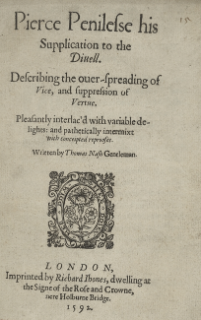
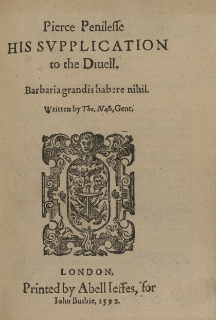
One of the most obvious differences between the first and second edition is that they have different title pages, even though they were printed within months of each other. The first edition was published by Richard Jones, who had also published Christopher Marlowe’s Tamburlaine the Great in 1590. The second edition was, however, published by another printer, John Busby, and has a shorter and less descriptive title.
Prefaces
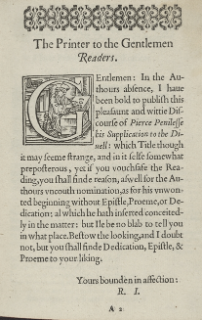
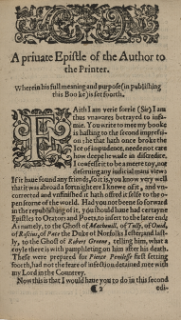
Another major change is the replacement of Jones’ letter to the reader (which he explains was written ‘in the Authours absence’) with a nominally ‘private’ letter written by Nashe to ‘the printer’. In the first preface, Jones is keen to reassure his reader about the lack of a customary dedication or preface. In fact, Nashe had intentionally left his preface till the end of his book, and Jones somewhat undermines the surprise by mentioning it in his letter. In the second preface, we learn a bit more about why Nashe may have chosen a different publisher for his second edition. Nashe claims that he was unaware that Jones had published Pierce Penilesse, as he was indeed absent from London during the plague that summer. He was probably staying at Archbishop Whitgift’s household in Croydon, where he was preparing for his play Summer’s Last Will and Testament to be performed at the Archbishop’s Palace. From the second preface we also learn that Nashe is displeased that the first edition was ‘uncorrected and unfinished’, which may suggest that some of the changes that we will see in the next edition are authorial corrections. Nashe also promises to write additional material for the book: ‘Epistles to Orators and Poets’, but ultimately none of these were ever printed.
Something else to note about the Richard Jones letter, is that the woodcut used for the ornamental letter ‘G’, which depicts a scholar working at his desk, was also used in a book called An astrological discourse (1583), written by Richard Harvey.
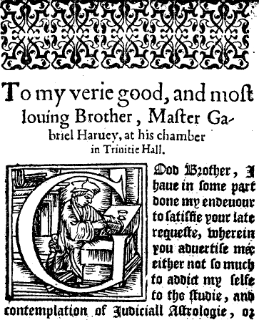
(Richard Harvey, Dedicatory letter to An Astrological Discourse (1583) sig. A2. Reproduction of Folger Library copy available on EEBO.)
After the publication of Pierce Penilesse, Nashe would go on to have a long-running feud with Richard’s brother, Gabriel Harvey, who is also the dedicatee of An astrological discourse. The fact that a student writing at a desk is surrounded by the letter ‘G’ for ‘Gabriel’ is likely a coincidence, but in hindsight seems an appropriate choice given that Gabriel Harvey was known as both a scholarly commentator, and Nashe’s nemesis.
Missing marginal notes

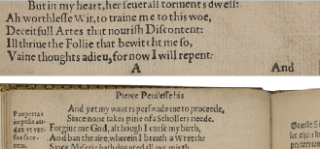
(Edition 1, sig.B1v) (Edition 2, sigs.A1-A1v)
Here we can see that a marginal note: “Ingenio perij, qui miser ipse meo” which appears at the top of the second page in the first edition, has been left out of the second edition, where it should appear at the bottom of the first page. The quotation is from Ovid's Tristia (Sorrows) in which the exiled poet curses his muse, and translates as "it was my own talent which brought me into misery". This is fitting as the note appears next to the line “Ah worthless Wit, to traine me to this woe” in the first edition.
While this missing marginal note was accidentally removed in the second edition, in the third, fourth, and fifth editions, almost half of the marginalia in the original edition were intentionally removed, either for reasons of censorship, or because the author wanted them removed, or because they took too much effort to reproduce in the age of the manual hand press. The question for the modern editor is: should you include all these marginal notes, or not?
Corrections
Another question for the editor of Pierce Penilesse, is in some ways more difficult. While the problem of the two prefaces and lost marginalia may be solved by including both prefaces and all the marginalia, so that the reader can see what was removed, the main text has a lot of corrections made between the first and second edition, and even more corrections made between the second and third edition. Does the editor assume that it was the author’s intention to change the text? Nashe did, after all, write in his letter to the printer that he was unhappy that the first edition had been rushed through the press ‘uncorrected and unfinished’. For example, there are some changes to the second edition which seem to be authorial concerns, for example exchanging one name ‘Ladie Manibetter’ with a different one of equal length: ‘Swin-snout’. A change of content like this doesn't save on space, implying that it is an intentional change made by the author.


(Edition 1, sig.C2v) (Edition 2, sig.B1v)
However, some of the changes may have been made by any one of the various members of the print shop- maybe the typesetter needed to squash in some words into a smaller space on the page, and decided to make certain words or a sentence shorter in order to fit.


(Edition 1, sig.B4) (Edition 2, sig.A3v)
For example, here we have a sentence which in the first edition reads “some two or three hundred Angels”. In the second edition this has been cut down to “by som two or three angels”. Is this intentional, or did the typesetter accidentally skip over the word ‘hundred’? It looks like it may have been an accident, because in the third edition, the amount of angels is re-emphasised: ‘some two or three hundred angels at least.’
Sometimes these corrections are a mixture of authorial changes, and print shop error. For example, at one point the narrator ‘Pierce Penilesse’ is complaining how poorly scholars are paid in comparison to uneducated artisans.


(Edition 1, sig.D1) (Edition 2, sig.B3)
A humanities education will ‘scarce get a Scholler bread and cheese’ says Pierce in the first edition, however, this is changed to ‘scarce get a paire of shooes and a Canvas-dublet’ in the second. This change makes Pierce’s comment more satirical, as he moves from ‘not enough money for sustenance’ to ‘not enough money for new clothes’; maybe he wants Pierce to sound more pompous. But something seems to have gone wrong at the point where the typesetter is reading Nashe’s correction, because he loses the words ‘a scholar’ in making this change. In the third edition, this new error is corrected, so that it finally reads as we think Nashe intended it to read: ‘the seaven liberall Sciences and a good leg, will scarse get a scholler a paire of shoos, and a Canuas-dublet.’ Ultimately, the modern editor must decide what the most accurate version of the text is.
To take a closer look at the two editions of Pierce Penilesse, you can click here for the first edition or here for the second edition on the Folger's LUNA webpage or look at the slideshows below. (N.B. if the slides do not show below, you may need to click on 'load unauthenticated scripts' at the top of your web browser.)
These images are used by permission of the Folger Shakespeare Library under a "Creative Commons Attribution-ShareAlike 4.0 International License"




